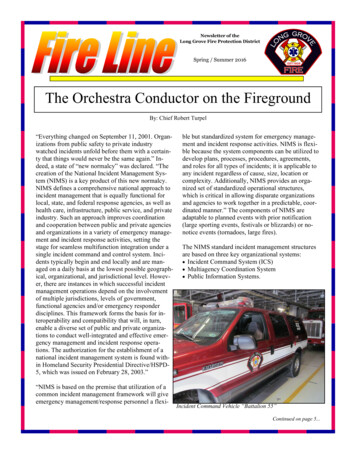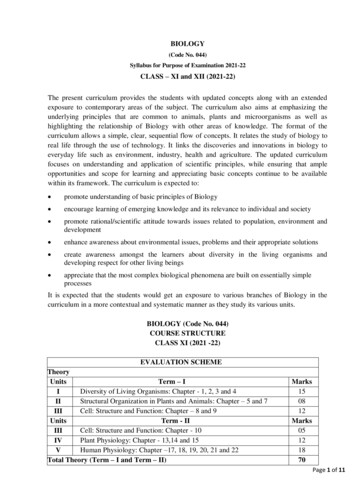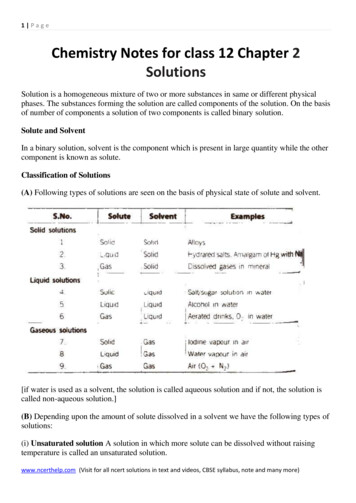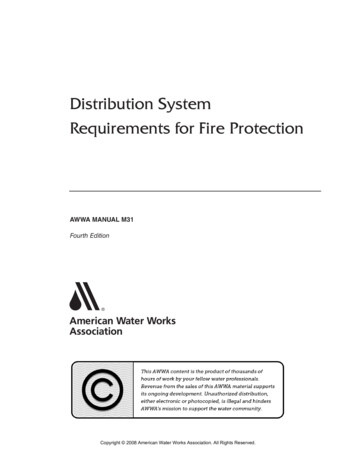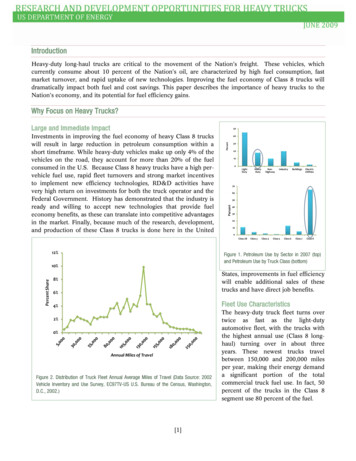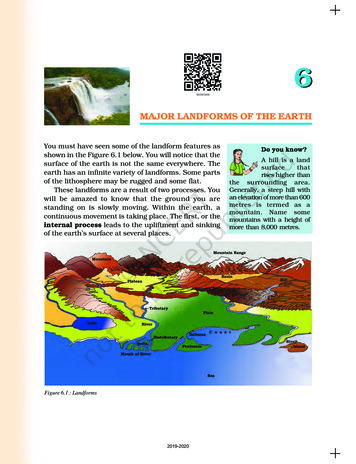
Transcription
6MAJOR LANDFORMS OF THE EARTHYou must have seen some of the landform features asshown in the Figure 6.1 below. You will notice that thesurface of the earth is not the same everywhere. Theearth has an infinite variety of landforms. Some partsof the lithosphere may be rugged and some flat.These landforms are a result of two processes. Youwill be amazed to know that the ground you arestanding on is slowly moving. Within the earth, acontinuous movement is taking place. The first, or theinternal process leads to the upliftment and sinkingof the earth’s surface at several places.Figure 6.1 : Landforms2019-2020Do you know?A hill is a landsurfacethatrises higher thanthe surrounding area.Generally, a steep hill withan elevation of more than 600metres is termed as amountain. Name somemountains with a height ofmore than 8,000 metres.
Let’s DoMaking ofMountain :a1. All you require is apile of paper.2. Put the papers onyour table.3. Push the papersfrom both sides byyour hands.4. The sheet will befolded and rise intoa peak.5. You have made amountain!In the same processour Himalayas andtheAlpswereformed!The second, or the external process is the continuouswearing down and rebuilding of the land surface. Thewearing away of the earth’s surface is called erosion.The surface is being lowered by the process of erosionand rebuilt by the process of deposition. These twoprocesses are carried out by running water, ice andwind. Broadly, we can group different landformsdepending on elevation and slope as mountains,plateaus and plains.MOUNTAINSA mountain is any natural elevation of the earthsurface. The mountains may have a small summit anda broad base. It is considerably higher than thesurrounding area. Some mountains are even higherthan the clouds. As you go higher, the climate becomescolder.In some mountains, there are permanently frozenrivers of ice. They are called glaciers. There are somemountains you cannot see as they are under the sea.Because of harsh climate, less people live in themountain areas. Since the slopes are steep, less landis available for farming.A Fold MountainCrustFigure 6.2 : Fold Mountains (Himalayas)40THE EARTH : OUR HABITAT2019-2020
Mountains may be arranged in a line known asrange. Many mountain systems consist of a series ofparallel ranges extending over hundreds of kilometres.The Himalayas, the Alps and the Andes are mountainranges of Asia, Europe and South America, respectively(Figure 5.1). Mountains vary in their heights andshape.There are three types of mountains- FoldMountains, Block Mountains and the VolcanicMountains. The Himalayan Mountains and the Alpsare young fold mountains with rugged relief and highconical peaks. The Aravali range in India is one of theoldest fold mountain systems in the world. The rangehas considerably worn down due to the processes oferosion. The Appalachians in North America and theUral mountains in Russia (Figure 5.1) have roundedfeatures and low elevation. They are very old foldmountains.Block Mountains arecreated when large areas arebroken and displacedvertically. The uplifted blocksare termed as horsts and thelowered blocks are calledgraben. The Rhine valleyand the Vosges mountain inEurope are examples of suchmountain systems. Locatethem on the world map inthe atlas and find out somemore examples of this typeof landforms.Volcanic mountains are Figure 6.3 : A Block Mountainformed due to volcanicactivity. Mt.Kilimanjaro in Africa and Mt.Fujiyamain Japan are examples of such mountains.Mountains are very useful. The mountains are astorehouse of water. Many rivers have their source inthe glaciers in the mountains. Reservoirs are madeand the water is harnessed for the use of people. Waterfrom the mountains is also used for irrigation andgeneration of hydro-electricity. The river valleys andterraces are ideal for cultivation of crops. Mountainshave a rich variety of flora and fauna. The forestsprovide fuel, fodder, shelter and other products likeDo you know?MaunaKea(Hawaii) in thePacific Ocean isan undersea mountain. Itis higher than MountEverest being 10,205metres high.41MAJOR LANDFORMS OF THE EARTH2019-2020
Figure 6.4 : A Volcanic Mountaingum, raisins, etc. Mountains provide an idyllic sitefor tourists. They visit the mountains for their scenicbeauty. Several sports like paragliding, hang gliding,river rafting and skiing are popular in the mountains.Can you name some places in the Himalayasassociated with these sports?Can you name this sport?Figure 6.5 : PlateauPLATEAUSA plateau is an elevated flat land. It isa flat-topped table land standingabove the surrounding area. Aplateau may have one or more sideswith steep slopes. The height ofplateaus often varies from fewhundred metres to several thousandmetres. Plateaus, like mountains maybe young or old. The Deccan plateauin India is one of the oldest plateaus.The East African Plateau in Kenya,Tanzania and Uganda and theWestern plateau of Australia are otherexamples. The Tibet plateau (Figure 5.1, p.31) is thehighest plateau in the world with a height of 4,000 to6,000 metres above the mean sea level.Plateaus are very useful because they are rich inmineral deposits. As a result, many of the mining areasin the world are located in the plateau areas. The42THE EARTH : OUR HABITAT2019-2020
African plateau is famous for gold and diamond mining. In India huge reserves ofiron, coal and manganese are found in the Chhotanagpur plateau.In the plateau areas, there may be several waterfalls as the river falls from agreat height. In India, the Hundru falls in the Chhotanagpur plateau on the riverSubarnarekha and the Jog falls in Karnataka are examples of such waterfalls.The lava plateaus are rich in black soil that are fertile and good for cultivation.Many plateaus have scenic spots and are of great attraction to tourists.PLAINSPlains are large stretches of flat land. They are, generally, not more than 200metres above mean sea level. Some plains are extremely level. Others may beslightly rolling and undulating. Most of the plains are formed by rivers and theirtributaries. The rivers flow down the slopes of mountains and erode them. Theycarry forward the eroded material. Then they deposit their load consisting of stones,sand and silt along their courses and in their valleys. It is from these deposits thatplains are formed.Generally, plains are very fertile. Construction of transport network is easy.Thus, these plains are very thickly-populated regions of the world. Some of thelargest plains made by the rivers are found in Asia and North America. For example,in Asia, these plains are formed by the Ganga and the Brahmaputra in India andthe Yangtze in China.Plains are the most useful areas for human habitation. There is great concentrationof people as more flat land is available for building houses, as well as for cultivation.Because of fertile soils, the land is highly productive for cultivation. In India too,the Indo-Gangetic plains are the most densely populated regions of the country.Figure 6.6 : Plains43MAJOR LANDFORMS OF THE EARTH2019-2020
LANDFORMSFigure 6.7 : Rope Bridge(Arunachal Pradesh)Do you know?Swachh Bharat Mission:Healthy mind lives inhealthy body and for ahealthy body cleanenvironment particularlyclean water, air andhygienic surroundings arepre-requisites. SwachhBharatMission,agovernment of IndiaProgramme aims toachieve all these for people.AND THEPEOPLEHumans have been living ondifferent kinds of landforms indifferent ways. Life is difficult inmountainous areas. Plains providemuch better conditions. It is easyto grow crops, build a house or aroad in a plain than a mountain.Can you point out some differencesin the ways people live on differentkinds of landforms? Sometimes, Figure 6.8 : A polluted rivernatural calamities such as earthquakes, volcanic eruption,storms and floods cause widespread destruction. Huge lossof life and property takes place. By creative awareness aboutsuch incidences we may lower the risks.You may find out from your own surroundings in howmany ways we use the land and water. Quite often we usethe land in a wasteful manner, for example constructinghouses on a fertile land. Similarly we throw garbage onland or in water making them dirty. We should avoid usingsuch important gifts of nature in a careless manner. Theavailable land is not only for our use. It is our duty to leavethe earth a better place for future generations as well.1. Look carefully atphotograph nos. 1-10.Write one sentenceabout each of thephotograph.2. Name the landformfeatures shown in thephotograph nos. 1,2 and 7.3. What appears to be the main useof this land? (Photograph no. 9)4. What activities do you see in thephotograph nos. 3,6,8 and 9.44THE EARTH : OUR HABITAT2019-2020
5. What type of houses do you seein photograph nos. 4 and 5.6. Name the water sports/gamesshown in photograph nos. 3 & 8.7. Name two means of transportshown in photograph nos. 1 and 10.45MAJOR LANDFORMS OF THE EARTH2019-2020
1. Answer the following questions briefly.(a)What are the major landforms?(b)What is the difference between a mountain and a plateau?(c)What are the different types of mountains?(d)How are mountains useful to man?(e)How are plains formed?(f)Why are the river plains thickly populated?(g)Why are mountains thinly populated?2. Tick the correct answers.(a)The mountains differ from the hills in terms of(i) elevation(b)(iii) the plateaus(ii) Australia(iii) IndiaThe river Yangtze flows in(i) South America(e)(ii) the plainsThe Deccan Plateau is located in(i) Kenya(d)(iii) aspectGlaciers are found in(i) the mountains(c)(ii) slope(ii) Australia(iii) ChinaAn important mountain range of Europe is(i) the Andes(ii) the Alps(iii) the Rockies3. Fill in the blanks.1.A is an unbroken flat or a low-level land.2.The Himalayas and the Alps are examples of types ofmountains.3.areas are rich in mineral deposits.4.The is a line of mountains.5.The areas are most productive for farming.1. What kind of landforms are found in your state? Based on the reading of thischapter, say how they are of use to the people.Map Skills1. On an outline map of the world, mark the following :(a)Mountain ranges: Himalayas, Rockies and Andes.(b)Plateau : Tibet.46THE EARTH : OUR HABITAT2019-2020
highest plateau in the world with a height of 4,000 to 6,000 metres above the mean sea level. Plateaus are very useful because they are rich in mineral deposits. As a result, many of the mining areas . NCERT Book for C



